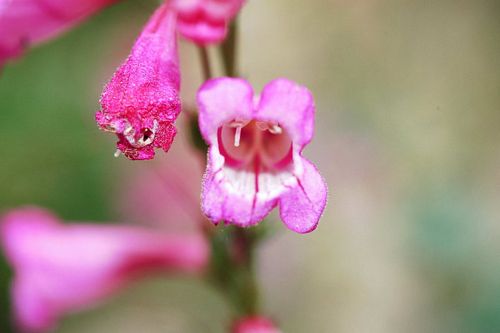Carried by 23 nurseries
View Availability at NurseryData provided by the participants of the Consortium of California Herbaria
View additional distribution information on the Jepson eflora
Penstemon pseudospectabilis is a species in the Plantaginaceae (Plantain) family known by the common name Desert Beardtongue or Desert Penstemon. It is native to the southwestern United States, where it grows in desert and plateau habitat types, such as sandy washes, scrub, and woodland. In California it is found primarily in the Mojave Desert. The plant is generally a shrub growing to a maximum height of one meter, with many erect stems. The thin leaves are roughly oval with wide pointed tips and serrated edges. They are arranged oppositely in pairs and many pairs are completely fused at the bases about the stem, forming a disc. The flower cluster bears tubular flowers with expanded, lobed mouths and hairy hairs on most surfaces, except the hairless staminode. The flower may be up to 2.5 centimeters long and is reddish pink in color.
Like most Penstemons, this species is very showy when in flower. Though native to hot, arid locations it is adaptable to most of southern California and is tolerant of garden conditions. give it plenty of sun and fast drainage, When in bloom it will be constantly in use by bees, butterflies and hummingbirds.
Perennial herb
1 - 3 ft Tall
3 ft Wide
Moderate
Evergreen
Slight
Pink, Red
Spring
Containers
Full Sun
Very Low
Max 2x / month once established
Moderate
Tolerates cold to 15° F
Fast
Rocky, sandy, gravelly.
Soil PH: 6.0 - 8.0
Deadheading will induce additional flowering. Dried seed heads can be sprinkled around to spread seed, or saved and propagated as described below.
For propagating by seed: 1 mo. stratification ( Plants of the Southwest 1986 ).
10, 12, 13, 14, 15, 16, 17, 18, 19, 20, 21
Gravelly or rocky places, usually mountain or high desert
Creosote Bush Scrub
Can be used with a variety of native plants including many not found in its native range, such as Manzanitas (Arctostaphylos spp.), Ceanothus spp., Brittlebush (Encelia spp.), Lupine (Lupinus spp.), California Poppy (Eschscholzia californica), Dudleya spp., and various cactus species.
Butterflies and moths supported
0 confirmed and 10 likely
Geranium Plume Moth
Amblyptilia pica
Verbena Bud Moth
Endothenia hebesana
Anicia Checkerspot
Euphydryas anicia

